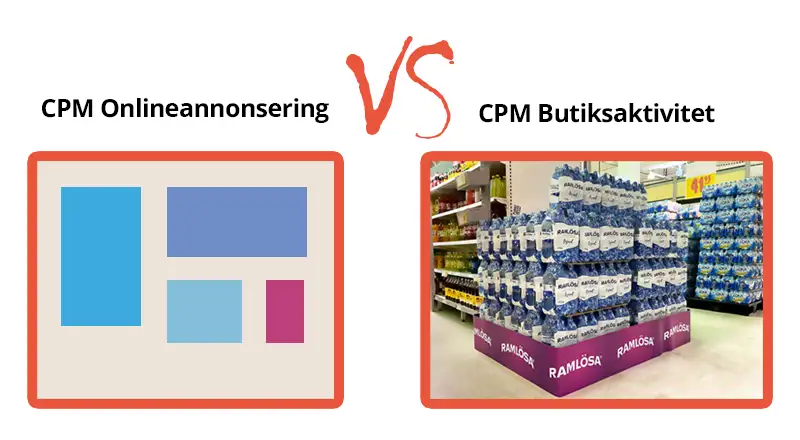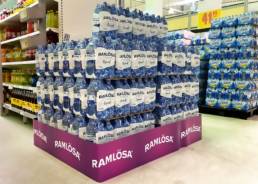FMCG: Unique CPM comparison between online and in-store advertising

Do you wonder how your in-store advertising performs compared to your online advertising?
In this article, we go through the result of in-store marketing by measuring CPM (cost per thousand impressions), a comparable metric that we will use to show the performance of in-store advertising by comparing it to online advertising. In the process, we will also review CPM for the most popular digital advertising platforms.
The strength of digital advertising is in it’s trackability and measurability, which makes it data-driven. In the same sense, we believe that data should drive decision-making of advertising in offline channels as well. With this article, we hope to give FMCG companies a unique perspective on costs and results of advertising in physical stores. Then put that data in the context of digital marketing by comparing these completely different mediums and channels, physical stores vs online advertising, with a common comparable metric, CPM.
What is CPM?
Cost per thousand impressions, or “CPM,” refers to the cost of displaying an advertisement one thousand times (known as “impressions”). Also known as cost-per-mille, CPM is the most common pricing model in online advertising. If you see an ad placement advertised as $1 CPM, this means you’ll pay $1 every time your ad is seen 1,000 times.
The typical formula is: CPM = Advertising cost / 1000 Impressions.
Companies see the best results from CPM strategies when they’re used in a wider marketing campaign that is focused on raising awareness of their product and/or brand recognition.
CPM for online advertising
We reviewed the CPM for the most popular online advertising platforms from “AdStage’s Paid Media Benchmark Report 2020” [1]. These are the median CPM from the Q1 2020 report sorted by price
The cost varies between $1.53 to 59.82 with an average of $13.19. These are general numbers not considering all the different factors, such as campaign goal, target group and segments.
Also, a reason for the major price difference can depend on e.g. the value of the audience. The audience value is heavily affected by how close the consumer is to making a decision or taking an action in that medium and channel.
For example, the audience in Google Ads Search (inbound/pull) is in search of a product/brand with an existing interest which makes it more valuable compared to Instagram Feed (outbound/push) where the goal ordinarily is to inspire and create interest.
Nevertheless, brands in the FMCG category usually strive to have exposure and reach wherever the target audience is. Mixing channels and mediums covering as many touch points as possible in the consumer decision journey.
CPM for in-store advertising
When consumers are in a physical store, they are obviously there to shop. Consumer Packaged Goods (CPG), or Fast-moving consumer goods (FMCG), is a unique category. Purchases can be frequent and habitual. The research phase for potential buyers tends to be short to non-existent. Consumers buy what they usually buy or make their purchasing decisions in-store.
Which makes the store, inevitably, the last touch point in the consumer decision journey. Thuse also making it the most important and valuable advertising channel for the CPG advertisers
Pallet-wrap
One of the most effective and simple ways of advertising in-store is with pallet-wrap. By breaking down the numbers for the pallet wrap we hope to illustrate the often overlooked strengths of this medium.
Median cost of pallet wrap for 1 physical store [2]
$15
The average lifetime of a pallet-wrap [3]
1 månad
The average number of visitors in a store (hypermarket) under 1 month [4]
200 000 besökare
Detta ger en CPM kostnad på $0,075.
Concluding that the median CPM for in-store display (pallet wrap), $0.075, is a fraction of the cost compared to online-advertising, without taking into account the importance of the channel. Knowing with certainty that the audience is there to shop, oftenly deciding which product and brand to buy on that occasion. On average, In-store advertising costs 160 times less than digital advertising
Source:
[1] https://thinkshiftinc.com/blog/digital-advertising-benchmarks-all-agrimarketers-should-know-updated-for-2022
See also:
https://www.statista.com/statistics/873631/social-media-advertising-cpm/
https://revealbot.com/facebook-advertising-costs
[2] Based on median meter price calculated from the 8 965 425 meter miniwells (pallet wrap) sold by Eurowell in the European market from 2020-01-01 to 2021-12-31.
[3] Studies based on the sale of 99 177 232 meter Miniwell Pallet Wrap produced by Eurowell from the year 1999 to 2021 showed the average lifetime of a pallet-wrap in store with moderate use to be between 3-8 weeks.
[4] Based on public data from visitor counters at hypermarkets in Sweden. Because of covid requirements stores have installed public counters showing the number of visitors in real time. We tracked data from 12 different stores across Sweden postcovid. The number of visitors varies between 200 000 – 300 000, we choose the lower point to reserve ourselves against margins of error.

EuroWell is a Swedish company which delivers products for in-store display and sales promotion throughout Europe.
Offices in Stockholm & Paris, POS experts boosting grocery sales.
Unique printing network, safe delivery, customer-focused.
19,000 projects in 35 countries since 1999, valued returning clients.
Read more
Out-of-stock on the Rise: A Cause for Concern
December 6, 2023
Facebook study: Consumers make purchase decisions in store
September 22, 2021